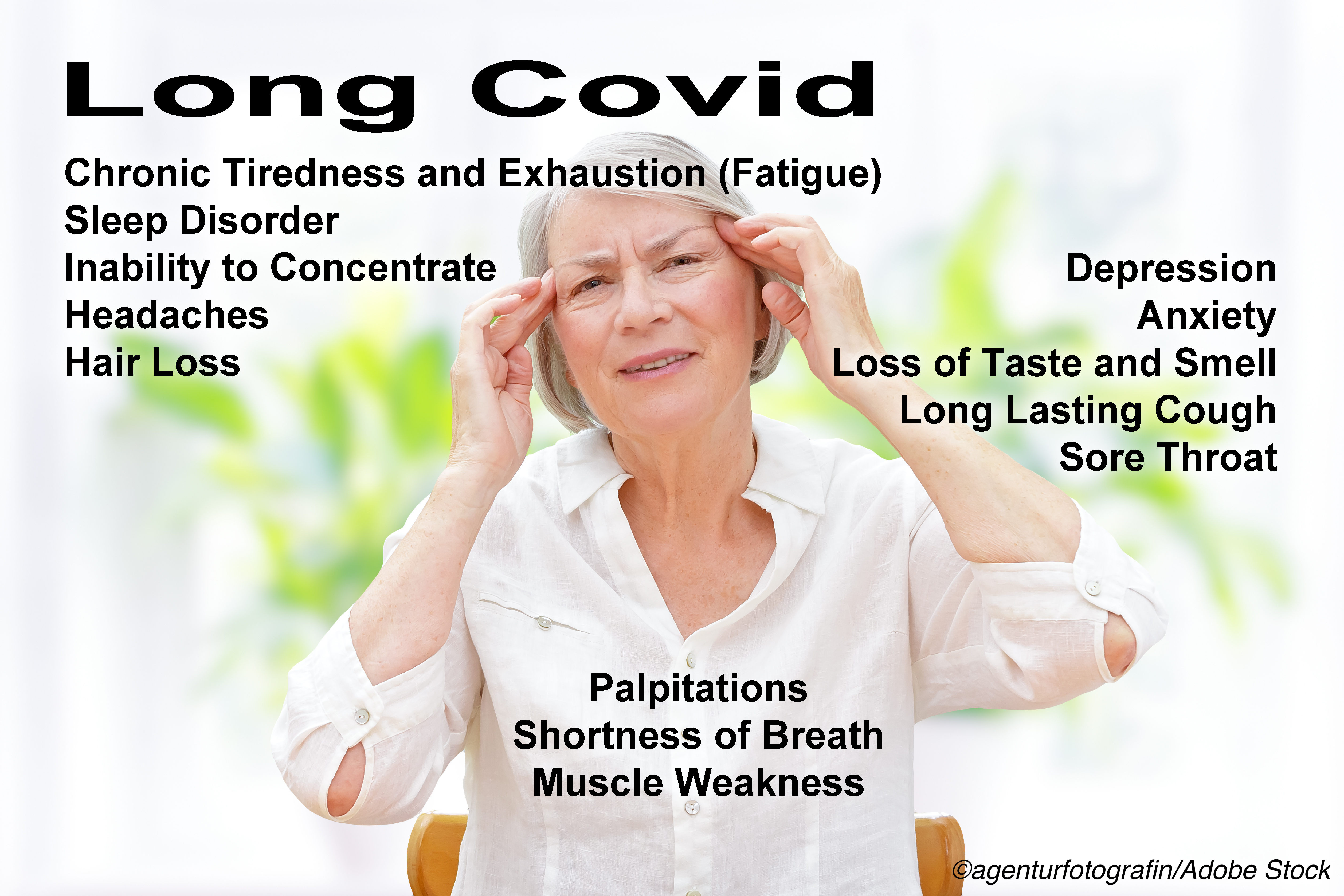
Within three weeks of a SARS-CoV-2 infection, one in seven U.S. adults developed at least one new type of clinical sequelae, according to an analysis of data from a large health insurance plan. This article, which was originally published May 24, 2021, details what researchers found. Click here to read the original article and obtain CME/CE credit for the activity.
Findings from a retrospective analysis of health insurance records suggest that as many as one in seven adults with Covid-19 developed at least one new condition requiring medical care during the post-acute phase of the illness starting three weeks after infection.
The newly diagnosed conditions involved the heart, kidneys, lungs, and liver, along with mental health complaints, wrote researcher Sarah E. Daugherty, of UnitedHealth Group, and colleagues, in the journal BMJ.
Fourteen percent of people with a laboratory confirmed diagnosis of SARS-CoV-2 infection developed at least one new type of clinical sequelae three weeks or more after initial diagnosis, a rate that was 5% higher than the reported rate among a comparator group of adults without a diagnosis of Covid-19 during 2020.
Women were more likely than men to report long-haul symptoms. While they were more common in older people, those with pre-existing health conditions, and those who had severe Covid-19, younger adults and those without pre-existing conditions were also at increased risk.
Daugherty and colleagues noted that with almost 70 million people infected with SARS-CoV-2 worldwide, the number of patients affected with long-haul symptoms can be expected to continue to grow.
“To manage these patients effectively, understanding the incidence and natural history of these sequelae is important,” they wrote. “Our results provide clinicians with a comprehensive understanding of the excess risk for over 50 clinical morbidities across multiple organ systems affecting adults aged ≤65 after the acute phase of SARS-CoV-2 infection. Knowing the magnitude of risk for rare and common clinical sequelae might improve the diagnosis and management of individuals infected with SARS-CoV-2.”
It could also help providers and other stakeholders anticipate what they might expect with regard to lingering health issues to “improve planning on the use of healthcare resources,” they wrote.
The study merged claims, laboratory, and hospital data from sources within the UnitedHealth Group’s Discovery Database on adults between the ages of 18 and 65 with continuous enrollment in the health plan from January 2019 to the date of a diagnosis of SARS-CoV-2 infection. Data were also analyzed for three comparator groups: a 2020 group without a Covid-19 diagnosis, a historical 2019 group, and a historical group with a diagnosis of a non-SARS-CoV-2 viral lower respiratory tract illness.
Using ICD-10 codes, the researchers identified more than 50 clinical sequelae after the acute phase of SARS-CoV-2 infection (date of Covid-19 diagnosis plus 21 days).
Among the main findings:
- 14% of adults ages ≤65 who were infected with SARS-CoV-2 (27,074 of 193,113) had at least one new type of clinical sequelae that required medical care after the acute phase of the illness, which was 4.95% higher than in the 2020 contemporary non-Covid-19 comparator group.
- The risk for specific new sequelae attributable to SARS-CoV-2 infection after the acute phase—including chronic respiratory failure, cardiac arrythmia, hypercoagulability, encephalopathy, peripheral neuropathy, amnesia (memory difficulty), diabetes, liver test abnormalities, myocarditis, anxiety, and fatigue—was significantly greater than in the three comparator groups (2020, 2019, and viral lower respiratory tract illness groups) (all P<0.001).
- Significant risk differences because of SARS-CoV-2 infection ranged from 0.02 to 2.26 per 100 people (all P<0.001), and hazard ratios ranged from 1.24 to 25.65 compared with the 2020 comparator group.
In an editorial published with the study, Elaine Maxwell, PhD, of the National Institute of Health Research, wrote that the finding of a 14% increased incidence of new diagnoses within six months of a Covid-19 diagnosis is “strikingly similar” to the 13.7% increase in self-reported symptoms lasting for more than 12 weeks reported in a study from the U.K. Office for National Statistics.
And, although both Daugherty’s study and the earlier analysis reported higher incidence of long-hauler symptoms in those hospitalized with Covid-19, the higher incidence was also reported by patients who were not hospitalized.
“The absolute number of people reporting long Covid symptoms will be higher in the community owing to the (at least) 10-fold difference in the numbers admitted to hospital and those who stayed at home,” Maxwell wrote. “Primary care clinicians should expect patents with mild initial infections to report long Covid or post-Covid symptoms just as frequently as those who were critically ill.”
Maxwell cautioned that it is too early to predict how long clinical sequelae will persist after Covid-19, but she noted that “these symptoms clearly create a major personal burden for many people, with some individuals experiencing difficulty returning to work and some unable to care for dependents.”
She added that identifying risk factors for long-haul symptoms would “facilitate triage and faster access to specialist care.”
“However, one of the peculiarities of long Covid is its non-linear progression, hampering attempts to predict who will develop particular symptoms and when,” Maxwell wrote. “Risk factors differ for different new diagnoses, suggesting that a variety of mechanisms could be at play. Applying these risk factors to clinical practice will probably need long Covid to be subdivided into more specific phenotypes.”
Salynn Boyles, Contributing Writer, BreakingMED™
This research was funded by OptumLabs, which is the research and development arm of UnitedHealth Group.
Sarah Daugherty and other researchers are employees of UnitedHealth Group. The organization was not involved in the design or analysis of the study, data interpretation or the writing of the report.
Editorial writer Elaine Maxwell declared no relevant conflicts. She noted that the views expressed were her own and not nessarily those of NIHR.
Cat ID: 190
Topic ID: 79,190,730,933,190,926,192,927,151,928,925,934


